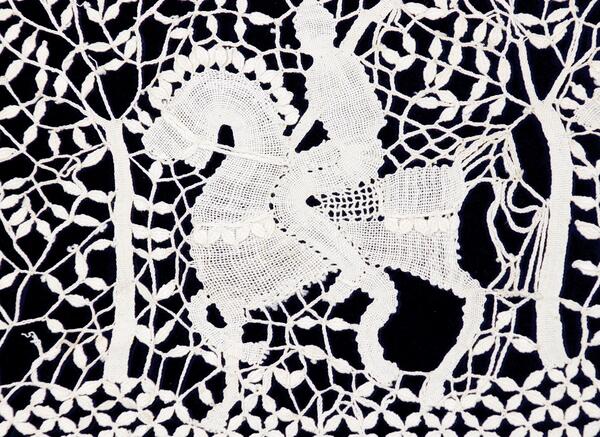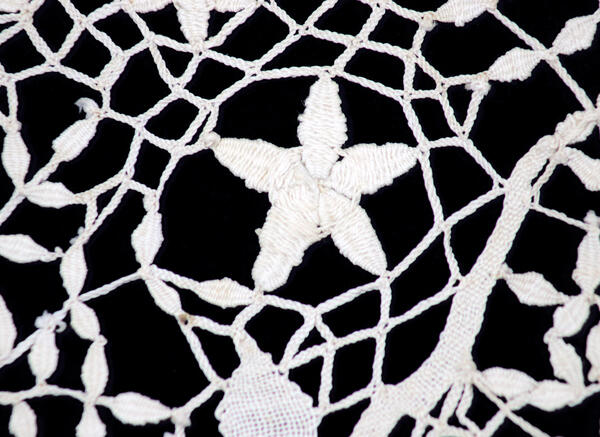In the Kirishsky district of the Leningrad region there is an ancient center of lace-making — Zakhozhye. There are only a few villages in Zakhozhye, but almost all the female inhabitants of these villages knew how to weave lace. Back in the middle of the 20th century, Zakhozhye was a remote, inaccessible area. The story goes that in the old days only one merchant knew the way from St. Petersburg to Zakhozhye. She bought lace in the villages and sold it in the city as Vologda lace.
The lace from Zakhozhye is peasant in its nature. The images of lace reflected the life of the village with its measured rhythm and traditional way of life. They have a deep connection with the world of animals and plants. Traditional patterns are “chicken paw” and “bear paw”. There are patterns of “cockroach eyes”, “butterfly”, and “daddy longlegs”, and each of them reflects real life observations. A pillow, or a ball, as they called it in Zakhozhye, stood in front of the lace maker on the table, in a basket, so that it was easy to turn it and set in a comfortable position. The ball was brought from house to house in the same basket. The craftswomen gathered in small groups for “conversations”: working together was more fun.
Local lace makers became famous in the 1930s, when the “Lacemaker” artel was created and their products — napkins, collars, curtains, and even hats and gloves — appeared at exhibitions in the Russian Museum in 1937 and 1938. The young lace maker Elizaveta Dmitrievna Zvezdina from the village of Dunyakovo became an active participant of the exhibitions. In 1940, Zvezdina completed the “Cavalry” valance for one of the major jubilee exhibitions. The valance has been exhibited for many years in the Russian Museum among the works of other artists of that time.
There are figures of riders alternating with handsome trees along the entire length of the valance. The dense silhouettes stand out against a transparent background. Riders in pointed budenovkas are slightly inclined forward, and their poses indicate that they are on the alert. The rifles behind the shoulders are sharply bent. Fairy-tale horses with steeply curved necks step from foot to foot in an even, easy way. Trees with slender trunks seem to sway with light branches and quivering leaves. The riders seem to ride in silence through the night forest, under the stars that dot the sky.
Elizaveta Zvezdina’s talent and creative initiative allowed her to step away from the traditional methods of Zakhozhye lace, and to find original modern methods of weaving, which no one dared to use after her.
The lace from Zakhozhye is peasant in its nature. The images of lace reflected the life of the village with its measured rhythm and traditional way of life. They have a deep connection with the world of animals and plants. Traditional patterns are “chicken paw” and “bear paw”. There are patterns of “cockroach eyes”, “butterfly”, and “daddy longlegs”, and each of them reflects real life observations. A pillow, or a ball, as they called it in Zakhozhye, stood in front of the lace maker on the table, in a basket, so that it was easy to turn it and set in a comfortable position. The ball was brought from house to house in the same basket. The craftswomen gathered in small groups for “conversations”: working together was more fun.
Local lace makers became famous in the 1930s, when the “Lacemaker” artel was created and their products — napkins, collars, curtains, and even hats and gloves — appeared at exhibitions in the Russian Museum in 1937 and 1938. The young lace maker Elizaveta Dmitrievna Zvezdina from the village of Dunyakovo became an active participant of the exhibitions. In 1940, Zvezdina completed the “Cavalry” valance for one of the major jubilee exhibitions. The valance has been exhibited for many years in the Russian Museum among the works of other artists of that time.
There are figures of riders alternating with handsome trees along the entire length of the valance. The dense silhouettes stand out against a transparent background. Riders in pointed budenovkas are slightly inclined forward, and their poses indicate that they are on the alert. The rifles behind the shoulders are sharply bent. Fairy-tale horses with steeply curved necks step from foot to foot in an even, easy way. Trees with slender trunks seem to sway with light branches and quivering leaves. The riders seem to ride in silence through the night forest, under the stars that dot the sky.
Elizaveta Zvezdina’s talent and creative initiative allowed her to step away from the traditional methods of Zakhozhye lace, and to find original modern methods of weaving, which no one dared to use after her.




